
Native copper:
This is man's first copper ore. Native copper is often alloyed with gold, silver, lead and mercury. Copper is widely distributed in nature. The metal is easily oxidizable and also easily reduced. It therefore occurs both as native copper and in its numerous compounds. Native copper is commonly, if not always, of secondary origin, either deposited from solution or formed by the reduction of some solid compound. Pseudomorphs of copper after cuprite are well known. W. S. Yeats has described pseudomorphs of copper after azurite from Grant County, New Mexico. W. Lindgren states that the vein of metallic copper at Clifton, Arizona, appear to have been derived from Chalcocite. The greatest known deposits of metallic copper are found in the Lake Superior region.
F. W. Clarke states its original home was, perhaps as sulfide, in the unaltered igneous rocks, but its concentrates are now found in the sandstones, conglomerates, and amygdaloids. In the sandstones and conglomerates it acts as a cement. Frequently native copper has been reported as holding enclosed nodules of native silver. The largest single mass of native copper ever found was discovered in the Minnesota mine, Michigan, in February, 1857. It was 45 ft. long, 22 ft. wide and 8 ft. thick. It weighed 420 tons. It was 90 per cent, pure copper and contained an appreciable amount of silver.
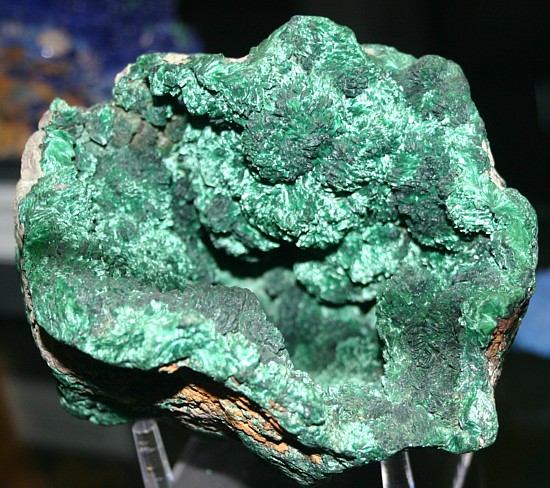
Malachite
The green carbonate. Commonly occurs massive, encrusting, stalactitic, or stalagmitic, and with a smooth, mammilla or botryoidal surface. The internal structure is often divergently fibrous and compact. Also occurs granular and earthy. The color is a bright green; different shades of the color following a concentrically banded arrangement. Malachite is found in the zone of weathering or gossan of copper lodes. Localities are Cornwall, Cumberland, Chessy (France), Spain, Siberia, Burra Burra Mine (South Australia), Chili, Pennsylvania, etc. The color-banding marks the successive deposits of the mineral, which has, in most cases, resulted from the percolation of water through copper-bearing rocks, and the subsequent deposition of the dissolved carbonate in fissures or cavities, the solution having apparently dripped in slowly, and the water evaporated, thus forming a series of layers in the same way that stalactites and stalagmites of calcite are formed by percolation of water through limestone. Malachite is valuable as an ore of copper. It is also, when cut and polished, used for ornamental purposes.
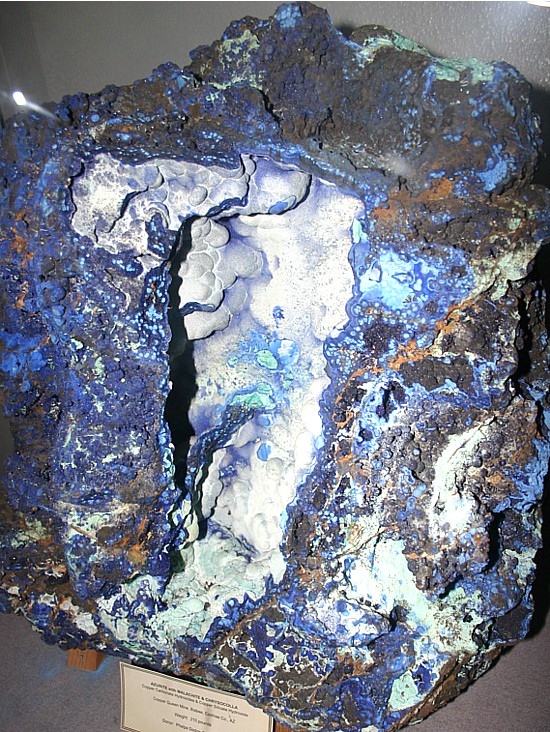
This dark blue colored high grade pocket is mostly azurite, a copper carbonate ore. It also features malachite (green) and chrysocolla (light blue). This rich pocket was mined at Bisbee in Arizona.
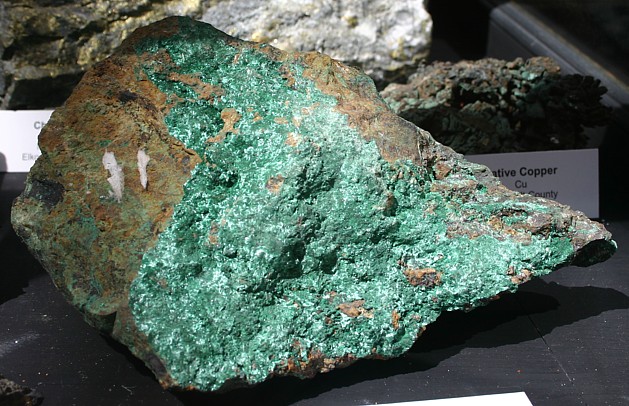
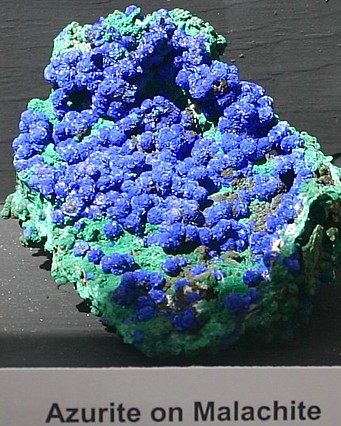
Azurite:
The blue carbonate. It has a deep azure blue color, whence the name. The two basic carbonates of copper, malachite and azurite, are common copper ores of secondary origin. They are formed in the upper portion of ore bodies by the action of carbonated waters upon copper compounds or by the reactions between cuprous solutions and limestone. At Corinth, Vermont, the author has found fine specimens of both malachite and azurite formed from chalcopyrite by the action of carbonated waters. Azurite is distinguished from malachite by its azure-blue color (while Malachite is green). It is found associated with other copper ores in the zone of weathering or gossan of copper lodes, and when occurring in sufficient quantity, is a valuable source of copper.
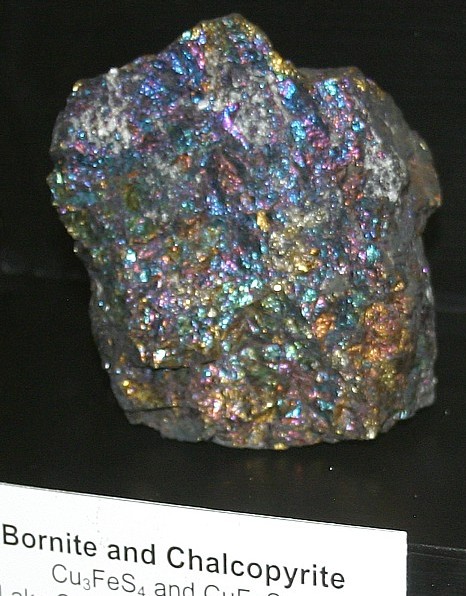
Bornite
Known as horseflesh ore by some miners, because of its fleshy pink color on fresh unoxidized surfaces. These surfaces quickly oxidize to multicolored iridescent colors - this leads to the name of peacock copper ore. Bornite and chalcocite are next in importance at least among the sulfides. These three minerals have been repeatedly indentified as of magmatic differentiation. They are doubtless the primary compounds from which the other ores in most cases were derived. B. Lotti has reported chalcopyrite, bornite and chalcocite in some ores.
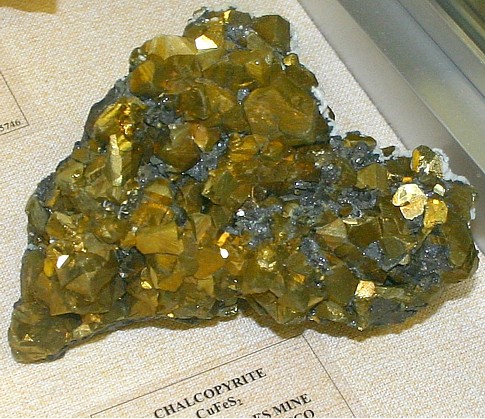
Chalcopyrite
Chalcopyrite is the most important ore of copper. Copper pyrites is the principal commercial source of copper. The mode of deposition of chalcopyrite in a certain number of deposits like those formed in limestone or at its contact with other rocks leads to this conclusion. The same authors state that the solutions may have come from above or below. The solutions were transported in the form of sulfates, either due to the oxidation of pyrite in the neighboring rocks, or in the form of aqueous emanations from an igneous magma during the later stages of its cooling. They also state that the metasomatic chalcopyrite deposits are due to ascending or descending solutions of sulfides carrying hydrogen sulfide and alkaline sulfides.The most important mode of occurrence of the mineral is in hydatogenetic veins associated with quartz, pyrites, etc. Some localities are Wallaroo (South Australia), Great Cobar and Broken Hill (New South Wales), Mount Morgan (Queensland), Shasta County (California), Sonora (Mexico), Bisbee (Arizona), Alaska, Chili, Monte Catini (Italy), Urals, and Rhodesia.
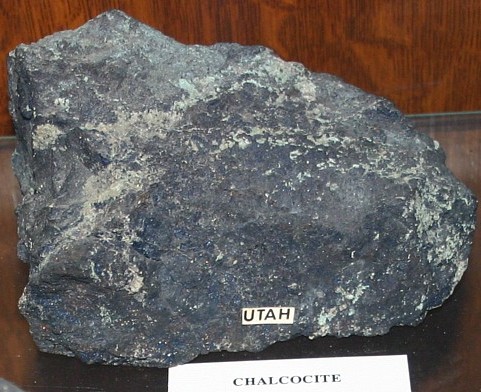
Chalcocite
A gray sulfide, also known as copper glance. Cupric solutions formed in the upper part of copper bearing ore bodies reacting upon pyrite precipitate chalcocite. Copper glance is a very valuable ore, but does not occur in very great abundance. Occurs in veins and beds associated with other copper ores, as in Cornwall, Siberia, Saxony, Kongsberg (Norway), Monte Catini (Italy), Mexico, Peru, Bolivia, Chili, etc.
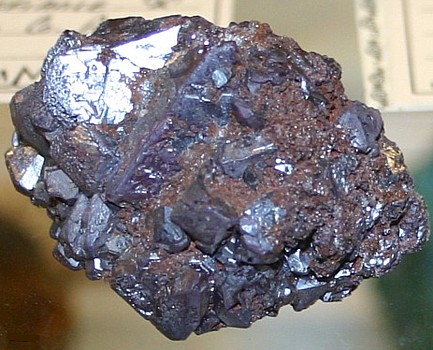
Cuprite
This is the red oxide of copper. The two oxides, cuprite and tenorite, are always of secondary origin. They may be formed by the oxidation and reduction of other copper minerals. Cuprite is by far the more important species. It has been observed as an incrustation upon ancient objects of copper or bronze.
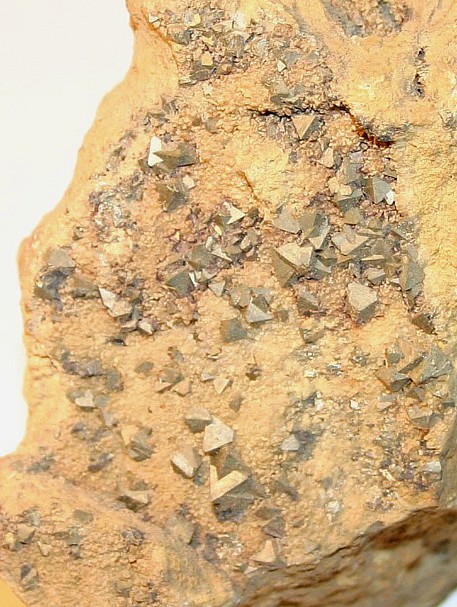
Tetrahedrite:
Known as gray copper, it is often argentiferous. Sulfide of copper and antimony,. Part of the copper is often replaced by iron, zinc, silver, or mercury. Part of the antimony is often replaced by arsenic, seldom by bismuth. It sometimes contains 30 per cent, silver in place of part of the copper, and is then called argentiferous grey copper ore, or silver fahlerz. Occurs associated with other ores of copper, and with pyrites, galena, sphalerite, etc. Localities are Levant (Cornwall), Andreasberg (Harz), Freiberg (Saxony), Przibram (Bohemia), Chili, Bolivia, and Arkansas and Colorado (U.S.A.).
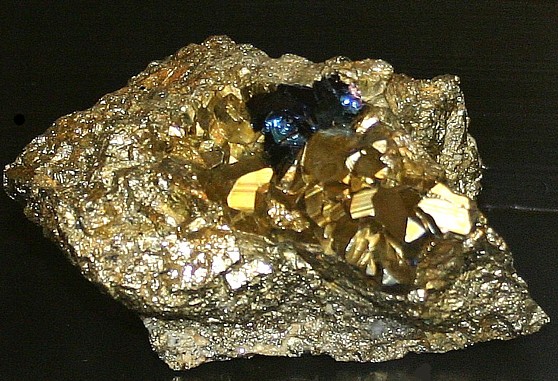
Covellite
This is an indigo blue sulfide that is a minor ore of copper. Covellite may be precipitated from copper sulfate solutions by the reaction of chalcocite. It is typically found in secondary enrichment zones in copper deposits.
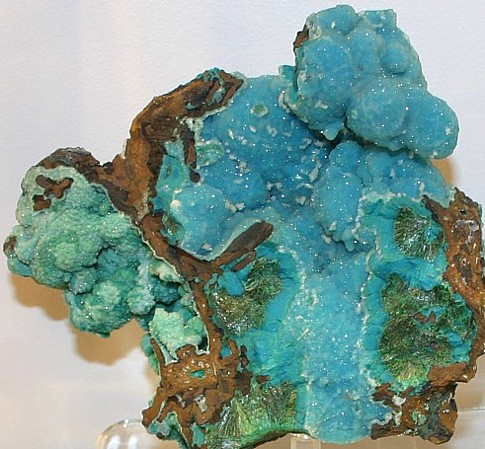
Chrysocolla:
Of the two silicates of copper, dioptase and chrysocolla, the first is rare but the second becomes an important copper ore in certain localities. According to F. W. Clarke, chrysocolla is formed by the action of silica-bearing waters upon soluble compounds of copper. Also that the mineral may possibly be produced during the processes of secondary enrichment. Occurs in the zone of weathering or gossan of copper lodes, and when found in sufficient quantity, constitutes a copper ore of some value, and is easily reduced when mixed with limestone. It seldom, from its impurities, yields more than 10 per cent, copper.
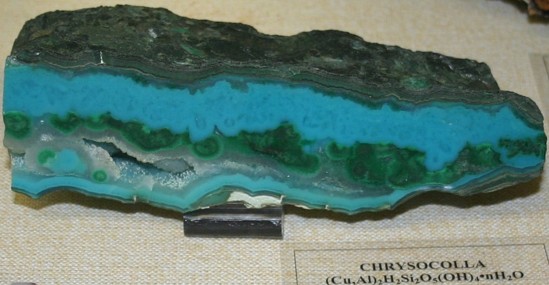
Chrysocolla:
This mineral is a common one and occurs in the secondary zone of many copper ore bodies. Notable localities are Cornwall, Saxony, Bavaria, Siberia, South Australia, Chili, and the United States. It is sometimes considered to contain a variable amount of free silica, and some specimens are sufficiently hard to scratch glass and to be cut and polished for jewelry.
Recommended
Metal Detectors
For Gold Prospecting:

Dioptase:
Emerald green crystals, combinations of prism and rhombohedron ; sometimes found in a massive form. Found in the zone of weathering or gossan of copper lodes, as at Chili, Nassau, Siberia. While it forms beautiful crystals, Dioptase is, because of its rarity, not a very important ore of copper.

Turquoise:
This mineral is a hydrous phosphate of aluminium, with a small percentage of copper oxide. Turquoise occurs in patchy deposits and seams in a trachyte in Persia, Nevada, Arizona and New Mexico. A few copper ore bodies have some turquoise as a minor ore mineral. Uses: Turquoise is much used in jewelry.

This beautiful specimen of copper ore comes from Nevada. The dark blue colored mineral is azurite, while the orange and gold colored material is limonite. The combination makes for a beautiful specimen.
